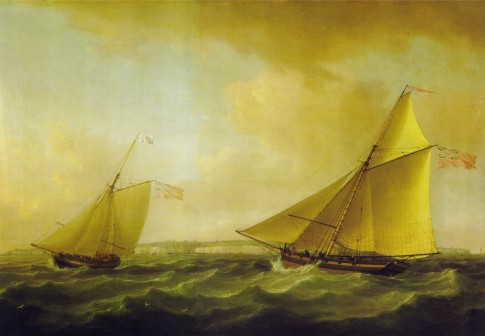A TRINITY HOUSE YACHT AND A REVENUE SERVICE CUTTER OFF RAMSGATE
By Thomas Whitcombe, c.1810
(Highest resolution available 5914×4103)
The decade of peace between the Seven Years War and the beginning of the War of American Independence saw a greater focus on domestic maritime problems, chief among which was smuggling. The long-established national taste for expensive wars imposed a financial burden which fell largely on the public. They were faced with heavy taxes on a bewildering array of goods, both exported and imported, and this led directly, quickly and inevitably to an explosion in smuggling. In wartime smugglers flourished with few men of ships to spare to guard the coasts, but during the peacetime everything changed. After the Seven Years War the Revenue Service expanded dramatically in both number and size of its ships. The vessel on the right is an armed revenue cutter. By 1773 there were 29 such vessels in service, and by the end of the War of American Independence there were 42, employing over 1000 men. Armed cutters were designed and built specifically to counter the threat of the smugglers. Fast and handy, they were built with shallow draughts which allowed them to penetrate deep inland.
While the Revenue Service was responsible for the security of Britain’s borders, Trinity House was responsible for their safety. The lighthouses, lightships and navigational marker buoys around the English coasts were all owned and run by Trinity House. The vessel on the left is a Trinity House yacht.
